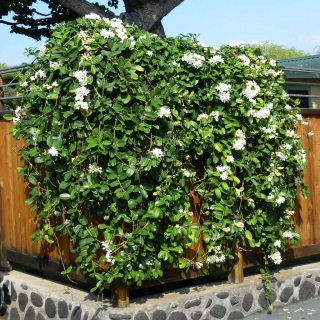

Stephanotis is a beautiful vine that deserves to grow for years. Keep it alive for more than a season by transplanting it to a pot to bring it indoors over the winter!
Stephanotis is a truly wonderful plant, and protecting it over the winter will help it produce more flowers in the following season.
The best call to let your Madagascar jasmine make it over the winter is to bring it indoors in a cool but non-freezing spot. Ideally, some type of heating element should be provided to ensure temperatures stay above 50°F / 10°C at all times until spring.
The following stephanotis transplanting guide works for a plant that has grown to up to 6 feet tall. Any larger would require some type of lifting device since the root clump would also get correspondingly larger.
Uproot your stephanotis after the blooming but before temperatures drop too much. Fall or autumn will maximize the chances of protecting your stephanotis.
Try to be helped by someone, since the root ball can get quite heavy, especially if the ground is moist.
Stephanotis, also called Madagascar jasmine, is a plant native to Madagascar. Summer temperatures there reach a mild (for the tropics) 80°F or 27° C, but winter temperatures there never get any colder than 48 or 50°F, equivalent to 9 or 10° C. This is in July since the island is in the Southern Hemisphere.
Although a very well-winterized Stephanotis might survive short bouts of colder temperatures that drop below that, it’s definitely not the usual.
Most Stephanotis plants will die if exposed to temperatures below 48°F / 9°C for more than a couple days. They won’t grow back at all after any time of frost or freezing.
A lean-in, windowed deck or patio or even a greenhouse with a small heating unit will be perfect for your transplanted stephanotis. That way it can stay anywhere between 50 and 60°F (or 13 to 15°C) during the entire winter.
It will enter a dormant phase, producing new roots during warmer days. During this time, water sparingly, only once the soil has dried out to a depth of an inch. Don’t add any fertilizer, the initial nutrients in the fresh compost should be enough.
Spring should start triggering new growth and stems will start shooting out.
You can replant your stephanotis outside towards mid-to-late spring. Most important is to avoid any risk of freezing has subsided. Make sure temperatures are consistently above 50°F (10°C).
 Two tips will help make this yearly transplanting easier:
Two tips will help make this yearly transplanting easier:
Read also:
Note that with these techniques and regular Stephanotis pruning, your vine will always remain within a certain size range. Adapt your lattice or trellis accordingly!